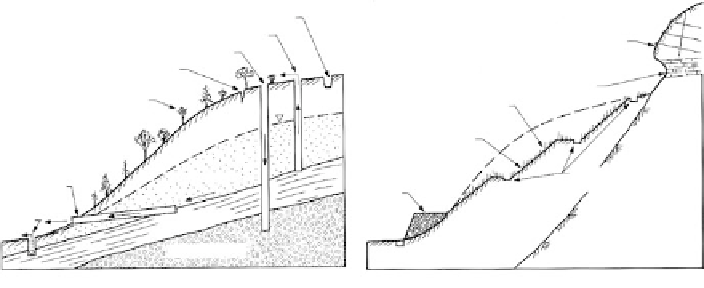Environmental Engineering Reference
In-Depth Information
depending on comparative economics. For high-risk conditions the hazard should be
eliminated.
Slope Stabilization
Methods
Slope stabilization methods may be placed in five general categories:
1.
Change slope geometry to decrease the driving forces or increase the resisting
forces.
2.
Control surface water infiltration to reduce seepage forces.
3.
Control internal seepage to reduce the driving forces and increase material
strengths.
4.
Provide retention to increase the resisting forces.
5.
Increase soil strength with injections. In a number of instances the injection of
quicklime slurry into predrilled holes has arrested slope movements as a result
of the strength increase from chemical reaction with clays (Handy and Williams,
1967; Broms and Bowman, 1979). Strength increase in saltwater clays, however,
was found to be low.
Stabilization methods are illustrated generally in Figure 9.99 and summarized in
Table
9.8
with respect to conditions and general purpose. “General Purpose” indicates whether
the aim is to prevent failure or to treat the slope by some remedial measure.
Selection
In the selection of the stabilization method or methods, consideration is given to a num-
ber of factors including:
Material types composing the slope and intensity and orientation of the discon-
tinuities
●
Slope activity
●
Proposed construction, whether cut or side-hill
●
Form and magnitude of potential or recurring failure (summary of preventive
and remedial measures for the various failure forms is given in
Table 9.9)
●
Lined drainage ditch upslope
Rock bolts or
cable anchors
Pumped wells
Vertical gravity wells
Seal fractures
Shotcrete or wall
in weak zone
Maintain slope
vegetation
Plant vegetation
Reduce slope
inclination
Retain slope
with berm,
buttress,
or wall
Rock
Subhorizontal
gravity drains
or galleries
To e
drain
Control runoff with
lined drains
Phreatic zone
Soil
pervious zone
(a)
(b)
FIGURE 9.99
The general methods of slope stabilization: (a) control of seepage forces and (b) reducing the driving forces and
increasing the resisting forces.



